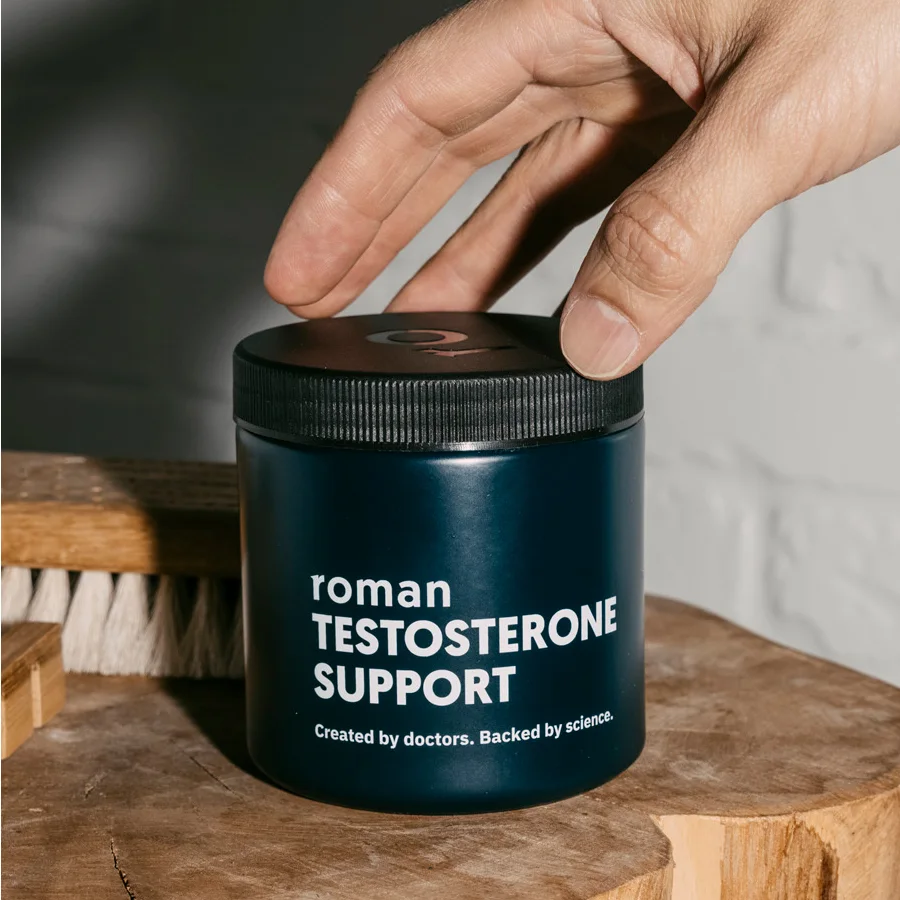Here's what we'll cover
Here's what we'll cover
Here's what we'll cover
Testosterone is a potent hormone that helps regulate sex drive (libido), erectile function, sperm production, bone density, muscle mass, and more. Many things affect testosterone levels, but we know that exercise (especially weightlifting) plays a role.
If you’re experiencing symptoms of low testosterone, like fatigue, loss of muscle mass, low libido, and erectile dysfunction, you might wonder: does lifting weights increase testosterone?
The short answer is probably, but keep reading to understand this relationship better.
Does exercising increase testosterone?
Studies have shown exercise can lead to increases in testosterone in men. However, these are typically short-term spikes, with levels usually returning to baseline within about 30 minutes (Riachy, 2020).
In women, T level increases during exercise are less predictable. In some cases, levels may decrease after exercise (Gharahdaghi, 2021; Kong, 2016).Overall, the relationship between exercise and T levels depends on various factors, including the types of exercise, your age, gender, body composition, health, and genetics. The following exercises impact T levels differently (Riachy, 2020).
Resistance training
Research suggests that resistance training, also called strength training or weight training, may lead to the most significant boost in testosterone levels.
The workouts that may boost T levels involve large muscle groups at fast intervals. So, for example, biceps curls may not be enough to raise levels since the biceps are relatively small muscles. But squats or deadlifts, which engage large muscle groups, are more likely to lead to a greater increase in testosterone. Heavier weights also help build muscle (Riachy, 2020).
While we know that testosterone replacement therapy can help with muscle growth in men with low T, it’s unclear if the short-term testosterone boosts from exercise are enough to increase muscle size (Storer, 2017). Other hormones and pathways are involved. However, research does suggest these acute spikes in testosterone probably trigger a cascade of events in the body that eventually help with muscle growth (Roberts, 2018).
High-intensity interval training (HIIT)
High-intensity interval training (HIIT) combines short bursts (intervals) of strenuous cardio to boost the heart rate, with rest periods. A typical routine would be fast sprints with shorter periods of less-intense activity or rest (Hayes, 2019).
While many studies suggest resistance training may be the best way to increase testosterone levels, there is some evidence that HIIT and endurance (aerobic) training may be better for older men. One research review found that both HIIT and endurance training led to slight increases in testosterone levels in older men, while resistance training did not (Hayes, 2019).
HIIT sessions can increase short-term, acute testosterone levels. However, they also tend to increase levels of the stress hormone cortisol, which reduces testosterone and can break down muscles. Some people may need up to 24 hours for their hormones to recover from a single HIIT session (Dote-Montero, 2021).
Endurance exercise
Studies suggest that extended, high-intensity aerobic workouts can boost testosterone. However, these workouts typically increase cortisol, which reduces testosterone (Riachy, 2020).
While basic aerobic workouts are not typically linked to higher testosterone levels, this form of exercise can improve cardiovascular health, bone density, and body weight. Weight loss often increases baseline testosterone levels in men with excess body weight (Kumagai, 2016; Anderson, 2016).
How do you know if you have low testosterone?
If you’re noticing symptoms of low levels of testosterone or have risk factors like obesity, it can help to talk to your healthcare provider.
Normal testosterone levels usually fall between 300–1,000 ng/dL in men and 15–70 ng/dL in women. Both blood and saliva tests can measure T levels, and there are even at-home testosterone tests available.
How to increase testosterone
If you have low T levels and symptoms that bother you, it’s best to discuss the issue with your healthcare provider. Testosterone replacement therapy (TRT)—typically injected or applied as a gel to the skin—may be one option. Keep in mind that men naturally lose testosterone as they age, and treatment has side effects, which should factor into your decision. If TRT isn’t a good option, your provider may recommend trying Clomid, an off-label treatment for low testosterone.
In addition to exercise, there are other ways to naturally increase your testosterone levels. These include:
Maintain a healthy weight, as excess body fat can reduce testosterone (Kumagai, 2016).
Eat a diet with fewer starches, sugars, and dairy and more vegetables, protein, and heart-healthy fats (Hu, 2018; Fantus, 2020).
Get enough sleep (Wittert, 2014).
Reduce stress, as cortisol may reduce testosterone levels (Harden, 2016).
Avoid medications and substances that can affect hormone levels (including excess alcohol, nicotine, recreational drugs, endocrine-disrupting chemicals, and some medications) (Wang, 2021).
Address nutrient deficiencies; make sure you’re getting enough vitamin D, zinc, and magnesium (Lerchbaum, 2017; Zamir, 2021).
You may try supplements such as ashwagandha, which has some evidence of boosting T (Lopresti, 2019).
Overall, healthy lifestyle choices like exercise can improve your health, which can ultimately increase T levels naturally. If you’re trying a new workout, you should check with your healthcare provider if you have any medical conditions.
DISCLAIMER
If you have any medical questions or concerns, please talk to your healthcare provider. The articles on Health Guide are underpinned by peer-reviewed research and information drawn from medical societies and governmental agencies. However, they are not a substitute for professional medical advice, diagnosis, or treatment.
References
Anderson, N. (2016). Does long-distance running have an effect on testosterone and bone health in men? Evidence-Based Practice , 19 (12), E4-E5. doi:10.1097/01.ebp.0000541589.72126.21. Retrieved from https://journals.lww.com/ebp/Abstract/2016/12000/Does_long_distance_running_have_an_effect_on.20.aspx
Dote-Montero, M., Carneiro-Barrera, A., Martinez-Vizcaino, V., et al. (2021). Acute effect of HIIT on testosterone and cortisol levels in healthy individuals: A systematic review and meta-analysis. Scandinavian Journal of Medicine & Science in Sports , 31 (9), 1722–1744. doi:10.1111/sms.13999. Retrieved from https://pubmed.ncbi.nlm.nih.gov/34022085/
Fantus, R. J., Halpern, J. A., Chang, C., et al. (2020). The association between popular diets and serum testosterone among men in the United States. Journal of Urology , 203 (2), 398–404. doi:10.1097/ju.0000000000000482. Retrieved from https://pubmed.ncbi.nlm.nih.gov/31393814/
Gharahdaghi, N., Phillips, B. E., Szewczyk, N. J., et al. (2021). Links between testosterone, oestrogen, and the growth hormone/insulin-like growth factor axis and resistance exercise muscle adaptations. Frontiers in Physiology , 11,
doi:10.3389/fphys.2020.621226. Retrieved from https://www.ncbi.nlm.nih.gov/pmc/articles/PMC7844366/
Harden, K. P., Wrzus, C., Luong, G., et al. (2016). Diurnal coupling between testosterone and cortisol from adolescence to older adulthood. Psychoneuroendocrinology , 73 , 79–90. doi:10.1016/j.psyneuen.2016.07.216. Retrieved from https://www.ncbi.nlm.nih.gov/pmc/articles/PMC5048541/
Hayes, L. D. & Elliott, B. T. (2019). Short-term exercise training inconsistently influences basal testosterone in older men: A systematic review and meta-analysis. Frontiers in Physiology , 9,
doi:10.3389/fphys.2018.01878. Retrieved from https://www.ncbi.nlm.nih.gov/pmc/articles/PMC6339914/
Hu, T. Y., Chen, Y., Lin, P., et al. (2018). Testosterone-associated dietary pattern predicts low testosterone levels and hypogonadism. Nutrients , 10 (11), 1786. doi:10.3390/nu10111786. Retrieved from https://www.ncbi.nlm.nih.gov/pmc/articles/PMC6266690/
Kong, Z., Fan, X., Sun, S., et al. (2016). Comparison of high-intensity interval training and moderate-to-vigorous continuous training for cardiometabolic health and exercise enjoyment in obese young women: A randomized controlled trial. PLOS ONE , 11 (7). doi:10.1371/journal.pone.0158589. Retrieved from https://journals.plos.org/plosone/article?id=10.1371/journal.pone.0158589
Kumagai, H., Zempo-Miyaki, A., Yoshikawa, T., et al. (2016). Increased physical activity has a greater effect than reduced energy intake on lifestyle modification-induced increases in testosterone. Journal of Clinical Biochemistry and Nutrition , 58 (1), 84–89. doi:10.3164/jcbn.15-48. Retrieved from https://www.ncbi.nlm.nih.gov/pmc/articles/PMC4706091/
Lerchbaum, E., Pilz, S., Trummer, C., et al. (2017). Vitamin D and testosterone in healthy men: A randomized controlled trial. The Journal of Clinical Endocrinology & Metabolism , 102 (11), 4292–4302. doi:10.1210/jc.2017-01428. Retrieved from https://pubmed.ncbi.nlm.nih.gov/28938446/
Lopresti, A. L., Drummond, P. D., & Smith, S. J. (2019). A randomized, double-blind, placebo-controlled, crossover study examining the hormonal and vitality effects of ashwagandha ( withania somnifera ) in aging, overweight males. American Journal of Men's Health , 13 (2), 155798831983598. doi:10.1177/1557988319835985. Retrieved from https://www.ncbi.nlm.nih.gov/pmc/articles/PMC6438434/
Riachy, R., McKinney, K., & Tuvdendorj, D. R. (2020). Various factors may modulate the effect of exercise on testosterone levels in men. Journal of Functional Morphology and Kinesiology , 5 (4), 81. doi:10.3390/jfmk5040081. Retrieved from https://www.ncbi.nlm.nih.gov/pmc/articles/PMC7739287/
Roberts, M. D., Haun, C. T., Mobley, C. B., et al. (2018). Physiological differences between low versus high skeletal muscle hypertrophic responders to resistance exercise training: Current perspectives and future research directions. Frontiers in Physiology , 9, 834. doi:10.3389/fphys.2018.00834. Retrieved from https://www.ncbi.nlm.nih.gov/pmc/articles/PMC6039846/
Storer, T. W., Basaria, S., Traustadottir, T., et al. (2017). Effects of testosterone supplementation for 3 years on muscle performance and physical function in older men. The Journal of Clinical Endocrinology and Metabolism , 102 (2), 583–593. doi:10.1210/jc.2016-2771. Retrieved from https://pubmed.ncbi.nlm.nih.gov/27754805/
Wang, X., Ha, D., Yoshitake, R., et al. (2021). Exploring the biological activity and mechanism of xenoestrogens and phytoestrogens in cancers: Emerging methods and concepts. International Journal of Molecular Sciences , 22 (16), 8798. doi:10.3390/ijms22168798. Retrieved from https://www.ncbi.nlm.nih.gov/pmc/articles/PMC8395949/
Wittert, G. (2014). The relationship between sleep disorders and testosterone in men. Asian Journal of Andrology , 16 (2), 262. doi:10.4103/1008-682x.122586. Retrieved from https://www.ncbi.nlm.nih.gov/pmc/articles/PMC3955336/
Zamir, A., Ben-Zeev, T., & Hoffman, J. R. (2021). Manipulation of dietary intake on changes in circulating testosterone concentrations. Nutrients , 13 (10), 3375. doi:10.3390/nu13103375. Retrieved from https://www.ncbi.nlm.nih.gov/pmc/articles/PMC8538516/










